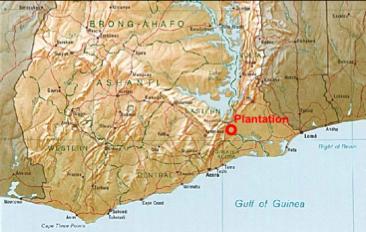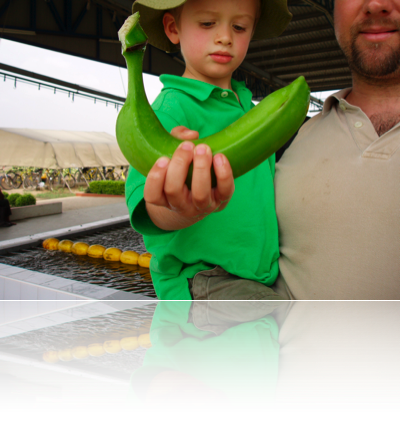A visit to the banana plantation
Whilst Central and South American remain the undisputed champions of the banana industry, Western African countries have been exporting bananas (and pineapples - yum!) to Europe for decades mostly from Cameroun and Cote d’Ivoire (Ivory Coast). For Ghana though, this is a brand new industry and one of Jerome’s friend has kindly arranged a guided tour of the only banana plantation in Ghana, just for us...
The plantation
Let’s get the numbers out of the way first and
put things into perspective. The Ghana banana plantation had its first banana tree planted in February 2005 and has grown to cover 800 hectares (approx. 2000 acres, or 800 football pitches) in just a couple of years.
The plantation is located near the Volta river – see map,  on which it relies to irrigate the trees. Without irrigation it would be impossible to grow bananas on this scale in Ghana, which is a rather dry country compared to neighbouring Cote d’Ivoire.
on which it relies to irrigate the trees. Without irrigation it would be impossible to grow bananas on this scale in Ghana, which is a rather dry country compared to neighbouring Cote d’Ivoire.
 on which it relies to irrigate the trees. Without irrigation it would be impossible to grow bananas on this scale in Ghana, which is a rather dry country compared to neighbouring Cote d’Ivoire.
on which it relies to irrigate the trees. Without irrigation it would be impossible to grow bananas on this scale in Ghana, which is a rather dry country compared to neighbouring Cote d’Ivoire.There are 5 reservoirs on the plantation from where the water is pumped. There are 1860 banana trees per hectares, so that’s nearly 1.5 million trees producing about 50,000 tonnes of fruit each year, enough to keep over 1300 people employed in this rural area.
This is merely a drop in the ocean of the banana industry (over 12,000,000 tonnes per year). Still, it remains an impressive sight.
Panoramic on banana plantation (1.7Mb)
Life of a banana
- The tree.
Let’s dispel a myth first of all: the banana tree is not a ‘tree’, from a scientific perspective it is a grass. The variety of banana used on plantations like this one, was created in a lab and every single tree (I’ll keep calling them ‘trees’ despite what I mentioned earlier !) first came from the companies labs in Cote d’Ivoire. At this stage, they actually look just like a bit of grass. After about three months in the comfort of the nurseries the plants are ready to be planted.
A healthy banana tree will grow one leaf per week and within 9 months it will have produced its fruits – the banana bunch, or regime de bananes in French. After this the tree will die out, but in the meantime it will have grown several other tree, which will itself produce its fruits in 8/9 months, etc.
- The fruit
Each banana tree will produce a flower. Inside each ‘petal’ will grow a ‘hand’ of banana. In order to control quality and productivity the number of ‘hands’ on the plantation is limited to 13/14. The rest is cut. The fruits are harvested about 3 weeks before they are ready for consumption. It is a delicate operation where great care is taken to avoid any shock. Pads are even used to carry banana bunches from the tree to the ‘banana train’ – the cable which is used to convey the fruits all the way to one of the five packing stations on the plantation.
The banana train (3Mb)
Packing and shipping
In the packing station each the hands of each banana bunch are cut and grouped in three categories of size.
Cutting the hands from the bunch (1Mb)
They are then subjected to draconian quality controls, which is apparently reflect what us European consumers want to see on the selves of our supermarkets - see the pictures for some examples. A quick look into the pile that has failed the quality control leave us bemused: who on earth has decided that I wanted perfect looking bananas ?! According to those standards Andy Warhol’s famous piece would have been dismissed out of hand ! These ‘second rate’ products will be sold and consumed locally in Ghana and in the neighbouring countries.
These ‘second rate’ products will be sold and consumed locally in Ghana and in the neighbouring countries.
 These ‘second rate’ products will be sold and consumed locally in Ghana and in the neighbouring countries.
These ‘second rate’ products will be sold and consumed locally in Ghana and in the neighbouring countries.Despite this being a recent plantation, almost everything is done manually. The fact is, bananas are so fragile that little can be automated. Pallets are put into refrigerated container to slow down the maturation process – the ideal temperature of 14C cannot always be guaranteed and on occasions, the fruits ripen to soon and a few pallets are lost during shipping.
Once in Europe, the bananas will be brought back up to temperature before being distributed to our favourite retailers.
What a journey for a banana !

Going Banana !
Tuesday, 30 January 2007

